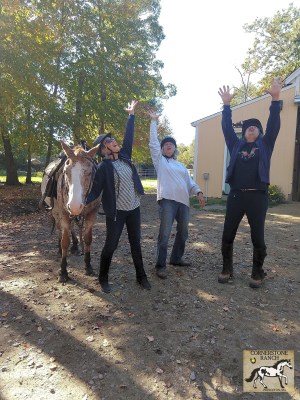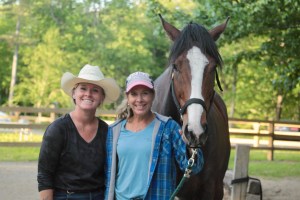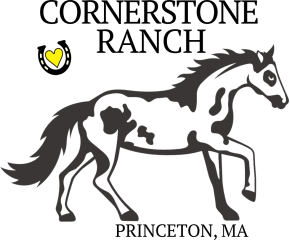DAY IN THE LIFE OF A WRANGLER

As the newest Wrangler at Cornerstone, life as a Wrangler involves a lot of learning, hard work, and fun! Our key responsibilities are caring for the horses and making sure our customers are safe and have a good time on their trail rides.
Our typical day starts with bringing the horses from their paddocks after they have been fed, offering them water and hay, and brushing them. They love to roll in the dirt, so we use several different types of brushes and combs to get them clean again. Next, we put on their saddles and pads, which is called “tacking,” and we clean and oil the saddles as needed.
By now customers have started to arrive. We greet them and welcome them to the Ranch, explain our no cell phone policy, and show them where to borrow helmets. If they need to sign a waiver (if their online waiver did not come through), we ask them to take care of that and check that it is completed.
Once the horses and customers are all ready, we assign horses based on height and weight, as well as who each group is composed of. Each horse can carry a certain weight based on the horse’s own weight, and we try to keep groups of friends or family together because we know their ride will be more fun that way. We bridle the horses and offer them water just before we line them up, and we ask customers to hold their horses in line using their reins while everyone gets in line. That way they have some time to bond with their horses and get to feel more comfortable with them.
Now it’s time to get them onto their horses. We check their girths and adjust their stirrups, then talk each customer through climbing onto their saddle while holding both horse and saddle steady. If anyone is nervous about riding, we try to comfort them. As a new Wrangler, I feel this is something I am especially useful at because I am relatively new to riding myself and remember what it feels like to be unsteady.
Once everyone is on their horse, the Lead Wrangler goes through some brief exercises to get the riders comfortable on their horses, then explains important topics such as how to use the reins and our rules for riding safely. We make sure everyone understands our rules to minimize confusion and lessen opportunities for unexpected circumstances to arise during the ride. The other Wrangler will often spray the horses with bug spray and perform one-on-one help if a customer needs more hands-on help to hold their reins correctly.
Now it’s time to go on the trail ride! The Lead Wrangler leads, while the Caboose brings up the rear for rides with six or more people. While we’re on the trail ride, we frequently remind customers about how to steer and give them a heads-up when we are coming up to an area where the horses are likely to try to snack. We chat with the customers closest to us and tell them interesting facts about the Ranch, horses, and local area. Some customers just want to quietly enjoy their ride; other customers want to talk about their lives and have someone to listen. The Wranglers communicate with each other via walkie-talkies in case the group is getting split up because of horses stopping to have a bathroom break or a snack.

Happy Riders back from a Trail Ride
When we get back to the Ranch, the Wranglers take photos of each customer and group on their horses before helping them dismount and thanking them for coming and explaining where to leave their helmets so we can disinfect them before they are used again. Then it’s time to get ready for the next ride!
If a ride is fewer than six people, one Wrangler may stay behind and help with paddock clean-up, which is a huge everyday task.
At the end of each day, every horse’s paddock needs to have been cleaned! When rides are over for the day, the Wranglers untack the horses, put away their saddles and bridles neatly, and bring them back to their paddocks. If more paddocks still need to be cleaned, we take care of that. We make sure the hitch and barn are cleaned and swept, and that everything is in place for tomorrow’s rides.
Pros
The pros of the Wrangler job far outweigh the cons! The pros are that you get to work with, and ride horses! You get to spend your day outdoors in the fresh air doing physical activities that make your body stronger and healthier. Your coworkers are hard-working people who share a similar interest in horses, and you get to bring joy to customers via horseback. It’s a great job for learning about horses and horse care, and you’re part of a small team helping a local, family-owned and operated business.

Julia, head riding instructor and barn manager; Susan, Ranch owner; and Dudley, sweet horse
Cons
The cons are that the pay is sometimes low, although gratuity can make a significant difference, and having time to accomplish all necessary tasks is a challenge, both due to the nature of the work. It can be hard to find time for bathroom breaks between rides, and snacks and drinks must be taken during the rides or while cleaning paddocks, without time for a typical lunch break.
Skills Required
- Horseback Riding background and/or currently enrolled in riding lesson program
- Psychology and people skills
- Riding and horsemanship
- Good judgment
- Public speaking
- Take charge and firmness
- Animal lover
- Good with all ages
- Detail oriented
- Familiar with outdoors (& lover of outdoors)
- Able to act quickly
- Communication skills
- Physically fit
Advice to Aspiring Wranglers
Attention horse lovers and wranglers-in-training! A career in wrangling requires prowess in horsemanship as well as competence in many areas not involving horseback riding. Good communication, knowing when to step up to take charge, with a focus on details helps create a positive vibe for riders leading up to, and throughout the rides.
Since wranglers walk distances to retrieve horses from pastures, lift saddles in preparation of the horses for rides, exercise agility mounting and dismounting while assisting customers along the ride, being physically fit is a requirement. As a wrangler, it helps to be familiar and comfortable with the outdoors and variable, unforeseen weather conditions.
Sometimes, riders arrive fearful which means wranglers need to project a calm, confident demeanor. In addition to possessing knowledge of the subject of horses and horseback riding, humor is a very helpful with keeping customers calm and entertained. Memorizing customer’s names is a beneficial skill to practice and perfect as it helps customers feel inclusive and engaged. There are many parallels in life surrounding working with people and horses. Do you have what it takes to be a wrangler, to be the best you can be for the horse you are riding and caring for, and all the different people-personalities you will come into contact with?
This post was written by Reba Frederics and originally published on Owl Guru: https://www.owlguru.com/review/wrangler-reba-frederics/
